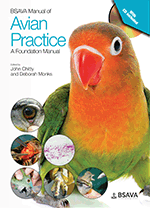
Full text loading...

Radiography is one of the most commonly used, noninvasive and direct diagnostic tools in veterinary medicine. Furthermore, most small animal practices already have an X-ray machine, and usually this works well for birds. This chapter provides advice on performing radiographic procedures and interpreting results, with example views of healthy birds and some common presentations.
Basic radiography, Page 1 of 1
< Previous page | Next page > /docserver/preview/fulltext/10.22233/9781910443323/9781910443323.18-1.gif

Full text loading...









































